#design curial
Text
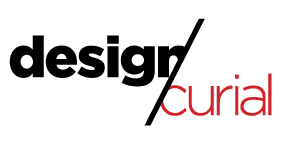

Ethereal Drinks Cabinet. With wall mounted bar / console
Made from sycamore and resin in a very organic sculptural form. Elegant and sinuous the piece shows real grace but also an unequivocal energy. The Ethereal series utilises unique techniques developed solely in Marc Fish's Studio in the UK. His work can be found in private homes in all corners of the globe - the Ethereal series sits well with more traditional furniture or contemporary modern pieces. The Ethereal series is the epitome of innovation from the studio that has become popular among collectors.
The Ethereal furniture is made from Marc's usual laminated veneers, with the important difference that he leaves negative space between them – treating them not as layers within a solid stratigraphy, but as fins within a more open structure. He then pours resin over these delicate, paper-thin armatures. The use of frosting and tinting in the resin produces mesmerizing visual effects, like sunlight through water currents or tree canopies. The principle of visual movement, which has been central to Marc's work for years, is quite literally transformed into another dimension. Having drawn his line and followed it this far, he is now moving beyond, exploring the more elusive and evanescent movements of space itself.
The skills of a craftsman: Perserverance

The Ethereal drinks cabinet doors glide sideways to reveal laminated shelves holding glasses and bottles, each shelf peeling away from the centre upright. The back panel's grain follows the form of this feature and the pattern continues outwards towards the open doors. This single design feature contains 2000 pieces of hand-cut veneer.
0 notes
Photo

Curial Aluminum is a minimal chair designed by Rick Owens for Carpenters Workshop Gallery. Le Corbusier and Marcel Breuer’s Brutalist architecture has had a strong pull influencing Rick Owens design sensibilities. Owens has an innate response to the ideas that both artists reduced from their large-scale building into smaller useful artworks.
15 notes
·
View notes
Text
Bibliography
100 Architects (2019a). BIG BANG - 100architects [online]. Available from: https://100architects.com/project/big-bang/ [Accessed May 2023].
100 Architects (2019b). HANG OUT [online]. Available from: https://100architects.com/project/hang-out/ [Accessed May 2023].
100 Architects (2020). CREEK PLAY [online]. Available from: https://100architects.com/project/creek-play/ [Accessed May 2023].
bassier (n.d.). Premium Vector | Vintage tattoo design of koi fish [online]. Available from: https://www.freepik.com/premium-vector/vintage-tattoo-design-koi-fish_19841180.htm [Accessed May 2023].
Brow, J. (2023). Gwen Stefani Insists She’s ‘Japanese’ & Defends Her Harajuku Era: Why ‘It Should Be Okay’ [online]. Available from: https://hollywoodlife.com/2023/01/10/gwen-stefani-japanese-harajuku-girls-era-interview/ [Accessed 7 May 2023].
Chin, T. (2021). This Mahjong Set Costs $425 and That’s Not Even What’s Wrong with It [online]. Available from: https://www.gearpatrol.com/home/a35129168/the-mahjong-line-cultural-appropriation/ [Accessed May 2023].
Counter-print (2023). COLOUR CLASH. Counter-print.
Daisie (2023). Daisie [online]. Available from: https://www.daisie.com/ [Accessed April 2023].
Davidge, J. (2014). Great Experiential Marketing: IKEA’s furnished climbing wall [online]. Available from: https://www.becausexm.com/blog/great-experiential-marketing-ikea-s-furnished-climbing-wall [Accessed May 2023].
Design and Art Direction (2022). D&AD Awards Winners 2022. [online] www.dandad.org. Available at: https://www.dandad.org/en/d-ad-awards-pencil- winners/ [Accessed 5 May 2023].
Design Curial (2014). James Holder on creating fashion brand Superdry - DesignCurial. [online] www.designcurial.com. Available at: https:// www.designcurial.com/news/super-fly-4395135 [Accessed 5 May 2023].
Duolingo (2019). Learn a Language for Free [online]. Available from: https://www.duolingo.com/ [Accessed May 2023].
Fielding, D. (2022). The Brand Book. Laurence King Publishing.
France-Presse, A. (2019). Ariana Grande mocked for Japanese tattoo typo: ‘Leave me and my grill alone’ [online]. Available from: https://www.theguardian.com/music/2019/jan/31/ariana-grande-mocked-for-japanese-tattoo-typo-leave-me-and-my-grill-alone [Accessed April 2023].
Fry, T. (2008) Design futuring: sustainability, ethics and new practice. Oxford: Berg
Google Chrome (2019). Tabby Cat [online]. Available from: https://chrome.google.com/webstore/detail/tabby-cat/mefhakmgclhhfbdadeojlkbllmecialg [Accessed May 2023].
Google Chrome (2023a). Scribe: AI Documentation, SOPs & Screenshots [online]. Available from: https://chrome.google.com/webstore/detail/scribe-ai-documentation-s/okfkdaglfjjjfefdcppliegebpoegaii [Accessed May 2023].
Google Chrome (2023b). Toucan - Language Learning [online]. Available from: https://chrome.google.com/webstore/detail/toucan-language-learning/lokjgaehpcnlmkebpmjiofccpklbmoci [Accessed May 2023].
Google Chrome (2023c). Ecowiser | Sustainable Shopping Assistant [online]. Available from: https://chrome.google.com/webstore/detail/ecowiser-sustainable-shop/mmegelfjbfgbmgkiggchjobabfgpbdmk [Accessed May 2023].
Han, C.A., Yoonji (2023). Gwen Stefani is only the latest glaring example of cultural appropriation in pop music. [online] Insider. Available at: https://www.insider.com/ gwen-stefani-cultural-appropriation-pop-music-problem-2023-1.
Master Blaster (2015). Superdry: The ‘Japanese’ fashion brand that most Japanese people have never even heard of [online]. Available from: https://soranews24.com/2015/11/03/superdry-the-japanese-fashion-brand-that-japanese-people-have-never-even-heard-of/ [Accessed May 2023].
Myerscough, M. (2014). Temple of Agape - Morag Myerscough [online]. Available from: https://www.moragmyerscough.com/commissions/temple-of-agape [Accessed May 2023].
Myerscough, M. (2018). Super Hot - Morag Myerscough [online]. Available from: https://www.moragmyerscough.com/commissions/super-hot [Accessed May 2023].
Myerscough, M. (2019). Love at First Sight - Morag Myerscough [online]. Available from: https://www.moragmyerscough.com/commissions/love-at-first-sight [Accessed May 2023].
Myerscough, M. (2021). Temple of Curiosity - Morag Myerscough [online]. Available from: https://www.moragmyerscough.com/commissions/temple-of-curiosity [Accessed May 2023].
Nousvous (n.d.). Southbank Centre: Festival of Love | Nous Vous [online]. Available from: https://nousvous.xyz/project/southbank-centre-summer-of-love/ [Accessed May 2023].
PayPal Honey (2023). Honey [online]. Available from: https://www.joinhoney.com/explore [Accessed May 2023].
Płudowski, W. (2021). The Westernisation of Japanese lettering. [online] Available at: https://repin.pjwstk.edu.pl/xmlui/handle/186319/615 [Accessed 5 May 2023].
Redman, C. and Maier, K. (n.d.). Craig & Karl [online]. Available from: https://www.craigandkarl.com/bread--butter?id=Xn2KTBAAAB8AeVZt [Accessed May 2023].
Redman, C. and Maier, K. (n.d.). Craig & Karl [online]. Available from: https://www.craigandkarl.com/mini-golf?id=Yo4tkBAAACQA-oOq [Accessed May 2023].
Ryan (2016). A Brand Case Study: The Superdry Appeal | The Branding Journal [online]. Available from: https://www.thebrandingjournal.com/2016/03/the-superdry-appeal/ [Accessed May 2023].
SHEIN (2023). Men Fish & Japanese Letter Graphic Tee | SHEIN UK [online]. Available from: https://www.shein.co.uk/Men-Fish-Japanese-Letter-Graphic-Tee-p-10270814-cat-1980.html?src_identifier=st%3D5%60sc%3Dmen%20fish%20and%20japanese%20letter%60sr%3D0%60ps%3D2&src_module=search&src_tab_page_id=page_search1686182069216&mallCode=1 [Accessed May 2023].
Sherbrooke Liquor (2023). HELL’S BASEMENT HURUHURU NEW ZEALAND HOPPED PALE ALE 6C [online]. Available from: https://shop.sherbrookeliquor.com/products/hell-s-basement-huruhuru [Accessed May 2023].
Sherin, A. (2017). Sustainable Thinking. Bloomsbury Publishing.
Southbank Centre (2023). Southbank Centre Food Market | Southbank Centre [online]. Available from: https://www.southbankcentre.co.uk/visit/cafes-restaurants-bars/scfood-market [Accessed May 2023].
Smith, K. and Hanover, D. (2016). Experiential marketing : secrets, strategies, and success stories from the world’s greatest brands. Hoboken, New Jersey: John Wiley & Sons.
Stouhi, D. (2021). Serena Confalonieri Transforms Abandoned Parking Lot in Milan into a Graphic Urban Playground [online]. Available from: https://www.archdaily.com/966152/serena-confalonieri-transforms-abandoned-parking-lot-in-milan-into-a-graphic-urban-playground [Accessed May 2023].
TedX Talks (2016). Kanji is Story, Art and Toy | Bret Mayer | TEDxHamamatsu [online]. Available from: https://www.youtube.com/watch?v=jUGTk0-GV4s [Accessed May 2023].
The Mahjong Line (2023). The Ocean Line: Barely Blue Release [online]. Available from: https://themahjongline.com/products/the-ocean-line-barely-blue-release [Accessed May 2023].
Three Hills Brewing (2017). Three Hills Brewing logo and identity, by Studio Crême [online]. Available from: https://identitydesigned.com/three-hills-brewing/ [Accessed May 2023].
USA Today (n.d.). Pop princess Katy Perry ignites racism debate: Opinionline [online]. Available from: https://eu.usatoday.com/story/opinion/2013/11/25/katy-perry-amas-racist-performance-asian-column/3709607/ [Accessed May 2023].
Van der Wagen, L. and White, L. (2018). Event management : for tourism, cultural, business and sporting events. South Melbourne, Victoria: Cengage Learning Australia.
Victionary (2021). More is more : designing bigger, bolder, brighter. Hong Kong: Victionary.
Westwood, J. (2022). How to Write a Marketing Plan. Kogan Page Publishers.
Wikidata (n.d.). University of the Arts London [online]. Available from: https://www.wikidata.org/wiki/Q2065666 [Accessed May 2023].
0 notes
Text
Restaurant #2: We Got Beef!
Interior of restaurant:

(Killip, Sophie. Design Curial, 8 Feb. 2019, www.designcurial.com/news/provisioners-london-modern-european-design-british-industrial-designers-6977543. Accessed 4 Apr. 2023.)
Beef Noodle Soup

(Tiffy. Tiffy Cooks, 21 June 2022, tiffycooks.com/instant-pot-authentic-taiwanese-beef-noodle-soup/. Accessed 3 Apr. 2023.)
Freddie's Rating: 4/10
0 notes
Text
Global Augmented Reality and Virtual Reality Market Size, Share and Demand Forecast to 2030
The Global Augmented Reality and Virtual Reality Market research report has been released by VynZ Research with several updates and analysis of market trends, share, size, demand, growth, challenges, opportunities and pre and post COVID-19 impacts.
Key Highlights of the Global Augmented Reality and Virtual Reality Market report
The projection period for this global market to grow is 2022-2030
The Global Augmented Reality and Virtual Reality Market size is estimated to reach USD 165.3 billion by 20230.
The market is projected to grow at a 50.6% CAGR
Covid-19 analysis and its impact on the market
Industry ecosystem to competitive landscape’s curial role in growth role
Challenges and opportunities to get boost from recent developments and technology advancement
Request to get the sample copy of the research: https://www.vynzresearch.com/ict-media/augmented-reality-and-virtual-reality-market/request-sample
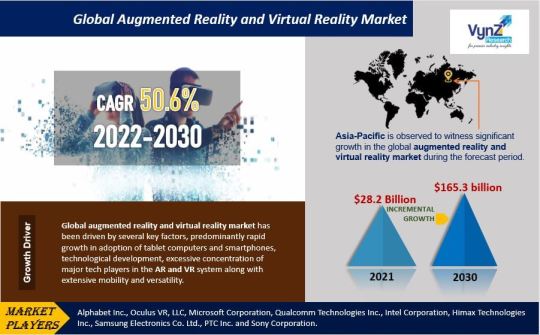
Market segment analysis
The Global Augmented Reality and Virtual Reality Market is segmented into these categories for this analysis: Component, Device Type, Application, and Geography. This segmentation allows executives to plan their products and spending based on the expected growth rates of each area: -
By Component (Hardware and Software)
By Device Type (AR Devices and VR Devices)
By Application (AR Applications and VR Applications)
By Region (North America, Europe, Asia-Pacific (APAC), Rest of the World (RoW))
For more insight: https://www.vynzresearch.com/ict-media/augmented-reality-and-virtual-reality-market
The Global Augmented Reality and Virtual Reality Market’s competitive viewpoint
This research is an invaluable resource for investors, shareholders, industry planners, and new and existing businesses trying to broaden their reach in the current Market scenario. While focusing on top companies and their corporate strategies, market presence, operating segmentation, aggressive outlook, geographical expansion, pricing and value structures, the study painstakingly takes into account the market analysis. The major market players are: -
Alphabet Inc.
Microsoft Corporation
Oculus VR, LLC
Qualcomm Technologies Inc.
Intel Corporation
Himax Technologies Inc.
Samsung Electronics Co. Ltd.
Seiko Epson Corporation
PTC Inc.
Vuzix Corporation
Sony Corporation
Osterhout Design Group (ODG) Inc.
Wikitude GmbH
Marxent Labs LLC
Blippar
Meta Company
Daqri LLC
Leap Motion, Inc.
EON Reality
Visteon Corporation
Zugara
Reason to buy this report
The report is unbiased and it provides the deep insight of global market including competitive and geographical landscape.
The report enlightens the large patterns, causes, and impact factors globally and locally.
Insightful study drills-out the main players of the global market and, their sources of income, share of the market, and the current course of events.
It looks into significant developments such as extensions, agreements, new product launches, and acquisitions on the horizon.
Research the market's potential, preferred position, opportunity, difficulty, restrictions, and hazards on a global and regional level.
Request for your custom requirements: https://www.vynzresearch.com/ict-media/augmented-reality-and-virtual-reality-market/customize-report
Customized research report
We offer clients specialized report services that take into account the main variables influencing the development of the worldwide Market. Feel free to call or drop your requirement to get the get customized research report.
Explore more reports by VynZ Research
Global Facial Recognition Market: https://www.vynzresearch.com/ict-media/facial-recognition-market
Global Smart Transportation Market: https://www.vynzresearch.com/ict-media/smart-transportation-market
Global Smart Cities Market: https://www.vynzresearch.com/ict-media/smart-cities-market
Global Hybrid Cloud Market: https://www.vynzresearch.com/ict-media/hybrid-cloud-market
Global Mobile Payment Technologies Market: https://www.vynzresearch.com/ict-media/mobile-payment-technologies-market
Global Cyber Security Market: https://www.vynzresearch.com/ict-media/cyber-security-market
Global Image Sensors Market: https://www.vynzresearch.com/ict-media/image-sensors-market
Global Blockchain Market: https://www.vynzresearch.com/ict-media/blockchain-market
Global Wireless Sensor Network (WSN) Market: https://www.vynzresearch.com/ict-media/wireless-sensor-network-market
Beauty Devices Market: https://www.vynzresearch.com/healthcare/beauty-devices-market
#Global Augmented Reality and Virtual Reality Market#Global Augmented Reality and Virtual Reality Market Trend#Global Augmented Reality and Virtual Reality Market Outlook#Global Augmented Reality and Virtual Reality Market report
0 notes
Text
Postmortem 2
I believe the one thing I learnt the most about making this game was to allow for improvements of the game in the future as the game was being made. This was done through soft coding relevant variables and maintaining a neat and organised code layout.
The main aspect of the readings that inspired my design process for Attack of the Junk Food was Fullerton’s discussion of cost restrictions in the week 7 readings. Fullerton discusses how there are restrictions to creative freedom, such as cost, time, and skill and that you need to evaluate your work to see what is needed and what non curial things can be done last or taken out of the plan. As I was developing AOTJF I had many ideas about features I wanted to add in such as a settings page, powerups, and a leader board but I didn’t have enough time to add these features into the game without compromising the bulk of the game. I cut those features out of the game and spent my time on improving what mattered. I was luck though because I had a bit of time left over to do a bit of work on the settings page.
The one thing I would change about how I developed the prototype would be to have a better plan for the game that contains much more ideas and plans that what I originally had. I believe that this would have helped with time management as I wouldn’t have spent so much time constantly changing already functional aspects of the game in order to implement a random idea I had and compromise time for other aspects of the game.
The one thing I would change about the design of the prototype would be the 2d assets I used for the fruit. They were smaller than I intended, and I believe that they make the gameplay too hard. I would like them to be a bit larger than they are right now.
0 notes
Photo

Joan Brossa, Les ungles del guant. Ronda de Rimbaud, Curial, Barcelona, 1974
7 notes
·
View notes
Photo

Pablo Bronstein: European building from the 1990's subsequently redecorated and abandoned (2014)
Ink and watercolour
design/curial
30 notes
·
View notes
Photo


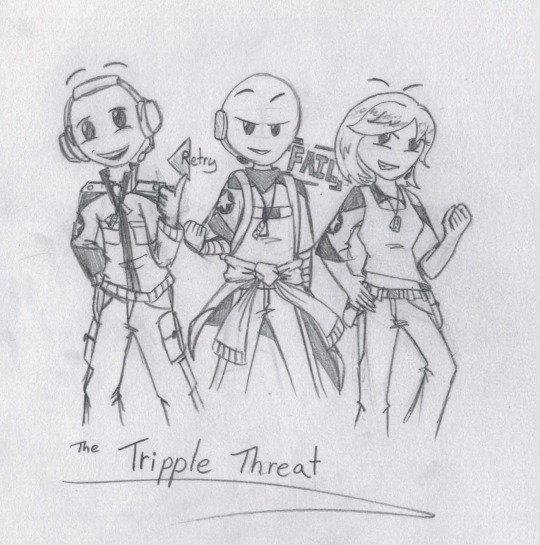
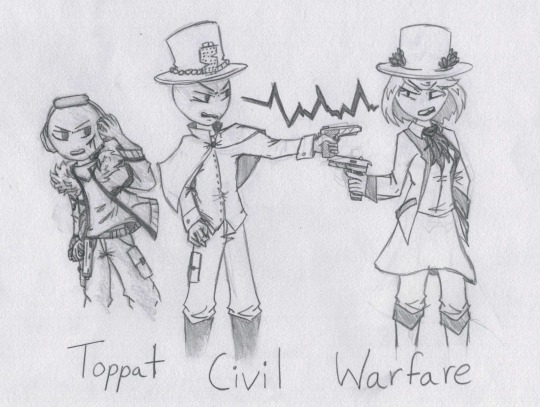
Henry Stickmin AU Concept Art/ideas
AU 1) Triple Warfare [1-4]
I’m thinking it could make a good ask blog due to the nature of the idea and how I’m planning on writing the story.
The idea for this one is basically a cross-over between (in my opinion) the best and worst ending for the characters (if we go by the fact in TT the main 3 (Henry, Elle and Charles) are friends and in TCW they’re trying to kill each other).
I really look forward to writing this one since in my head I’ve got the greatest ideas for how the conversations are going to go down between the two different groups of characters, like TT Charles is more of a cinnamon roll and then TCW Charles is like...well remember in Valiant Hero how he gets dark for a minute saying “It’s starting to... G E T P E R S O N A L”? Well when I saw that, I honestly thought Galeforce had died or something, so I’m working off of that idea to a bit more of an extreme since we get the whole Rapidly Promoted Executive ending in there to really annoy him.
AU 2) The Lost Children of the CCC [5-7 ]
This whole Au ended up being a spin-off from the idea of Right-hand Man’s origin story for the whole mystery name thing and Henry’s powers idea which just...spiralled out of control into something else completely and is strongly connected to the side comics (current & future) I’m working on.
The current story line I’m building the story around is after the Triple Threat ending, where a mysterious person offers Reginald a way out of the Wall for him and the Toppat’s for the small price of a blood sample form RHM and Toppat membership. I really like the dialogue scene in my head so here’s a little sample for you ^^
- - - -
[Reginald] And why would I agree to that?
[Person] “Because! You get ya freedom and I’d like ta say quite a valuable asset for the Toppat Clan…”
He watched Reginald's gaze remain cold and sceptical.
[Person] “But, if that’s not good enough for ya then let me put it crudely: I’ve been sent to obtain that blood sample and attain it I will. I personally like the Toppat’s, use ta hear all about ya as a kid, an’ this seemed like a great retirement idea; joinin’ ya all since this is my last job, and I’m out.
Think I can’t get it? Well I can. I’ll take it from his cold lifeless corpse as he lays there twitching on the ground, glazed eyes and the fading buzz of electronics in the air.
You think these guys here care? One less inmate- and a dangerous one at that- gone. All I have to do is say he threw the first punch, ‘I didn’t have a choice, I was fighting for my life! I thought I would have been a goner. I was so lucky that those cybernetics of his allow for easy disabling of life support systems with a correctly angled blow to this little spot here and here’.”
He twists his hand like on a nob by the neck and no doubt follows pulling essential wiring out with the over and a wide brimmed grin.
Reginald scowls back; he’d lost.
This guy is really going to make him choose between the life of his loyal Right-hand man and best friend, or the clans.
[Reginald] And if I do agree… how do I know you won’t betray us?
[Person] Asides from settin’ ya all free and joinin’ the Clan? Agree and you’ll find out in 10 minutes~
- - - -
(And then, I remembered one curial piece of info writing this awesome scene...
RHM isn’t a cyborg in triple threat -_-;
or is he~)
(Concept designs + more in original idea post)
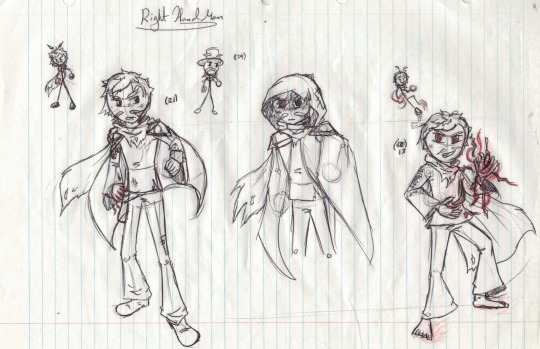


AU 3) When Endings Collide [8-9]
I don’t really have any sketches for this one (just some very rough first concepts for each of the endings), a handful of ideas and a rough storyline. It’s quite a complex story since it involves all 16 endings, so I haven’t done too much work on it and instead have put it aside for a later date since it’ll need a lot of planning and work to pull off effectively.
The basic idea I had for this one started with a “What if Valiant Hero Henry ended up in Triple Threat in the middle of a mission and proceeded to try and kill Elle (A Toppat in his ending) and then had a mental break down seeing a not dead Charles? And then what if Revenge Henry ended up in Toppat King in the middle of the government raid and in the middle of this proceeded to help a very confused Charles (who hates him) capture an equally confused Reginald and hand him over to the government (The idea for Revenge Henry working for the government came from this fantastic fic I recommend reading). And then I think I was messing with Stickmin Resort in either Valiant Hero or Broverts.” A lot of the over endings has been messing about with which ones work the best together since I haven’t quite figured out what to do with Cleaned ‘em Out - Little Nest Egg (below) & Pardoned Pals & Capital Gains I’ve missed ^^; .
And then once endings are sorted, next is figuring out how for all of this to happen and them all to end up in each other endings, which I have an idea for but definitely needs more work to run smoothly. I’m thinking the CCC and what if someone tried to use them and the chaos to make their perfect singular ending? Maybe one where a very hated protagonist never existed~
Again, I think this AU has a lot of potential to be great, but it’ll need a lot of work.


#henry stickmim collection#the henry stickmin collection#henry stickmin#ellie rose#charles calvin#general galeforce#triple threat#toppat civil warfare#triple warfare#rupert price#toppats#toppat charles#cyborg charles#toppat henry#completing the mission#triple threat ending#revenged ending#master bounty hunter ending#toppat king#valiant hero#stickmin space resort#toppat recruits#free man#au#fanfic#ask blog#work in progress#wip#ben mccoy#finn quayle
63 notes
·
View notes
Text
FOMA 44: Forgotten Sarajevo
During our online conversation Lejla texted me that it is difficult to come across reference material in Bosnia in general as libraries and archives have been burnt down and there hasn’t been enough digitisation.
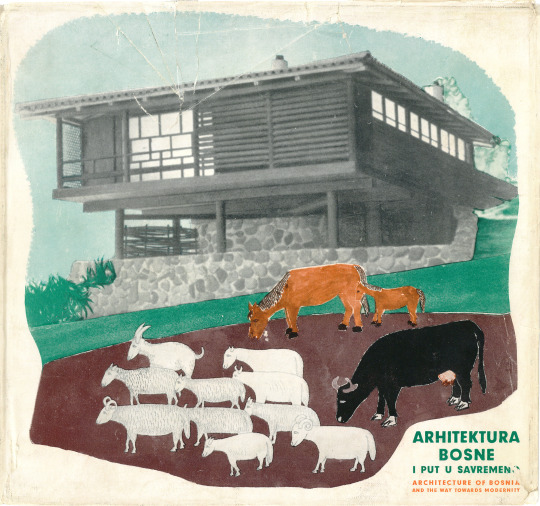
Architecture of Bosnia and the Way to Modernity by Dušan Grabrijan and Juraj Neidhard, Sarajevo 1957
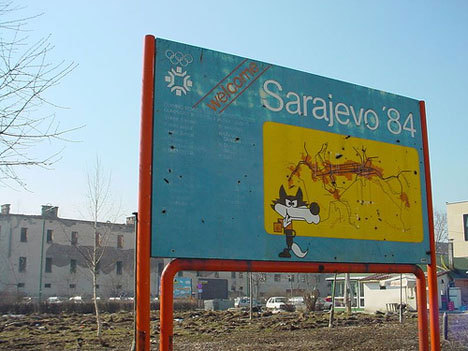
The 1984 Winter Olympics known as Sarajevo '84, was held between 8 and 19 February 1984 in Sarajevo, Yugoslavia.
Let's have a look of five impressive Forgotten Masterpieces in Sarajevo. Designed by Živorad Janković and Halid Muhasilović, Skenderija is a multi-functional cultural and sports centre completed in 1969. This building was the first of its kind in the former Yugoslavia and in many ways acted as a prototype for many similar complexes that were later built throughout the country. As such, Skenderija played a curial role in the development of not only the local architecture, but also of Yugoslavian modernist architecture as a whole. It was the first hybrid building in the former Yugoslavia that fused together many different functions (sports, performance, entertainment, shopping, food, service, etc.) within a singular multi-storey complex that employed a modernist aesthetics prevalent of the time.
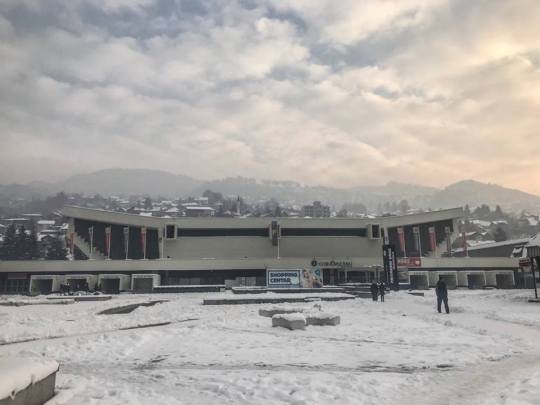
The complex consists of three buildings; a large sports hall in the first, a number of smaller sports halls in the second building and Dom Mladi (House of Youth) with cultural content in the third. | Photo Lejla Odobašić Novo
The buildings are arranged around an open plateau, a city agora, under which is located a subterranean commercial level with a circulation path that allows access all three buildings. The project was innovative in the complex construction system used that allowed for large spans. It also reflected the modernist ambition of honesty in the material use, with the concrete articulation of all the façades. In many ways, due to its scale and cultural significance, the complex shifted the symbolic gravitation from the old city centre and established an additional point of prominence. In urbanistic terms it expended the city beyond the exiting east-west axis and opened the south bank of the river Miljacka.


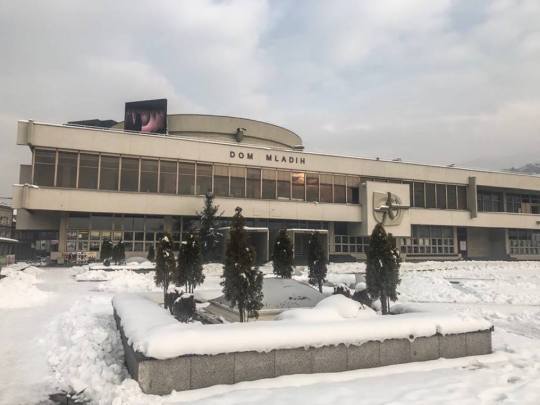
Skenderija allowed Sarajevo to take on a new cultural significance that would later be sealed by the Winter Olympics in 1984. | Photo Lejla Odobašić Novo
The Communist Party of Yugoslavia started the project of the Sarajevo’s main railway station as an architectural competition with the ultimate goal of physically uniting the country through its railway system. At the beginning of Socialist Yugoslavia, the country’s political views strongly aligned with those of the USSR and the remainder of the communist bloc. As such, Yugoslavian architecture at this time, although modernist in spirit was still heavily influenced by the social realism that was used as a political tool and prevailed in the majority of the eastern bloc countries.

The Railway station was opened in 1952 and in its thirty years of function, up until the siege in 1992, the building was one of the most monumental structures in Sarajevo. | Photo via Mirza Hasanefendic
Social realism in Sarajevo brought on a range of contradictions in its architectural articulation. It ranged from architecture for the masses most clearly articulated in the residential settlements for the worker’s housing to that of highly articulated and relatively well executed public buildings, mostly designed through architectural competitions.

The main railway station in Sarajevo reflects the complexity of a more western modernism. | Photo Lejla Odobašić Novo
Once the initial reconstruction phase after WWII was completed cultural and institutional buildings became the next phase of focus. One of these included the Ministry of Public Health. It is heavily modernist in nature, however, the social realist influence remains visible. It was built only a few years after the main railway station but the break away from the social realism is even more apparent in this case. This shift in architectural expression occurred as a direct result in the political and ideological drift between Yugoslavia and USSR.

The building relies on pure geometry, abstracted decoration in the form of vertical fins at the front façade, simplified openings and a receded top floor which allow for a terrace on the top floor. | Photo Lejla Odobašić Novo
The principal focus of the social realism buildings was an exaggerated scale in order to instill the notion of grandness of the state and to inspire deference towards the authorities, which in this case was the Communist Party of Yugoslavia. Since this building was designed and built as a Ministry of Public Heath, Ivanović strived to employ majority of these principles but he broke away from some keys aspect that defied socialist realism at the time.
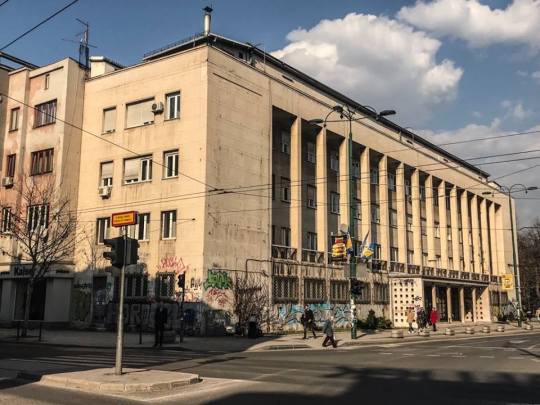
The building follows the rigid symmetry often employed by social realism and breaks a number of rules, which shift it towards a more ‘western’ modernist building. | Photo Lejla Odobašić Novo
The Communist party took control of Yugoslavia following the end of WWII in 1945. Like the majority of European cities, a considerable damage was suffered by the urban fabric in Yugoslavia as well. As such, one of the major tasks of the new socialist system was to rebuild as fast and as efficiently as possible. However, both the amount of resources and the number of available architects was limited and as such the initial wave of reconstruction was very utilitarian.
One of the most notable residential projects that dates back to the post-war period is the residential complex on Džidžikovac that resulted from a design competition set forth in 1947 and won by the above-mentioned Kadić brothers. The project was completed in just over a year which resulted in relatively poor construction quality, which was the case with many residential buildings constructed around this timeframe.

The design and the modernist spirit of the project render it as one of the most notable residential complexes in Sarajevo. | Photo Lejla Odobašić Novo
The complex contains three linear residential blocks each consisting of a number of three-storey interconnecting buildings that cascade along the existing topography. In addition, the three blocks are surrounded by open green space that integrates the building into the existing site forming a sense of a unified complex. Although the project has been declared as a protected national monument in 2008, the reconstruction done since the end of the siege in the 1995, has been to a large extent insensitive to the initial design principles of the Kadić brothers.
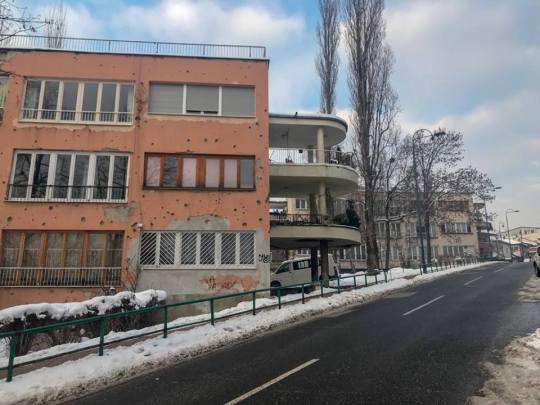
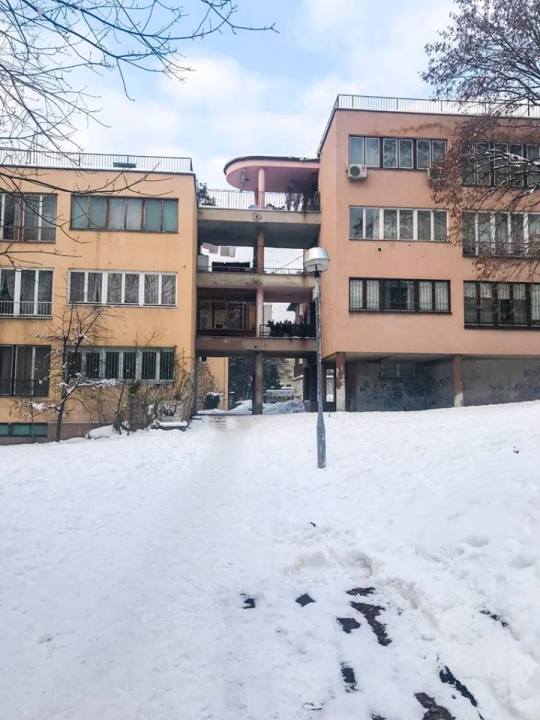

Each block have a set of semi-circular terraces suspended by receded columns - the signature feature of this project. | Photo Lejla Odobašić Novo
Completed in 1956, six years after the Ministry of Public Health, Residential Building and Šipad Headquarters breaks away from the social realist influence and draws inspiration from Oscar Niemeyer instead, thus creating one of the most prominent modernist buildings in Sarajevo.
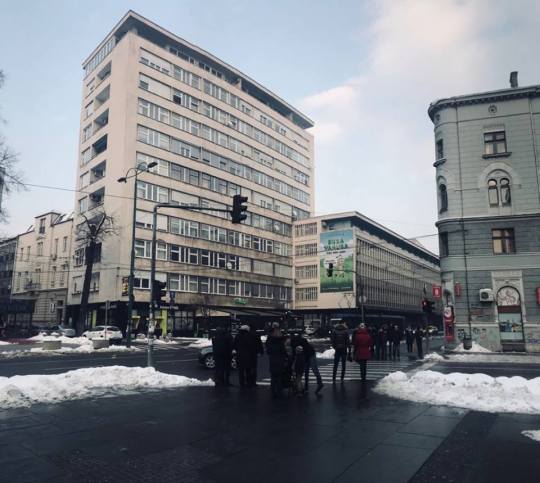
Although the two buildings are separate entities they lean on each other and share a part of the side wall. | Photo Lejla Odobašić Novo
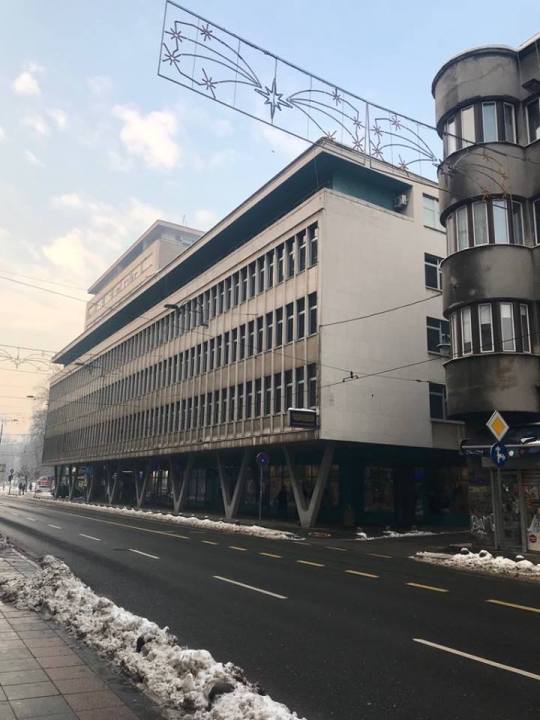

In order to allow for a continuous pedestrian flow, Ivanović frees part of the ground floor of the Šipad Headquarters, and thus creates a covered promenade lined with the distinct V shaped columns visually suspending the building off them. | Photo Lejla Odobašić Novo
---
#FOMA 44: Lejla Odobašić Novo

Photo by © Yasin Emir
Lejla Odobasic Novo is a Bosnian-Canadian architect and an architectural theorist who is currently working between Sarajevo and Toronto. She obtained her bachelor and master’s degrees from the University of Waterloo School of Architecture where she also held a research position and upon graduation worked as an Adjunct Professor at the Rome Campus. She holds a professional licence issued by the Ontario Association of Architects (2014) and is an Assistant Professor at the International Burch University in Sarajevo where she obtained her PhD and currently teaches architectural design and architectural theory. Lejla’s research focuses on the role of architecture, and in particular cultural heritage, in conflicted and contentious places. Within this field, she has carried out projects, exhibitions, publications and other cultural initiatives including her work with Liana Breser, Jerusalem-Sarajevo: In-between Cities, that was exhibited in Canada, UK, Bosnia and Croatia (2010-2011). She has also participated in DAAR Decolonizing Architecture residency and research group in the Palestine under Eyal Weizman, Sandi Hilal and Alessandro Petti (2010). Lejla is also a member of Kuma International, an International Center for the Visual Arts from Post-Conflict Societies. In addition to her academic work, she has also worked in architectural practices internationally including Toronto, London, Madrid, Rome and Istanbul.
49 notes
·
View notes
Photo
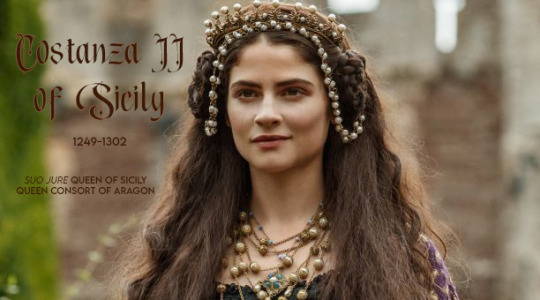
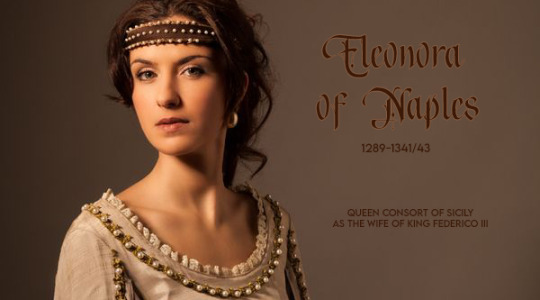
“Sicily’s women have always been shadowy figures, crouched quietly in doorways or gazing down the crowded streets from balustraded or shuttered windows. For most of the medieval period they have left no direct record of themselves, since, with a few exceptions, they could neither read nor write - and even the possession of literacy, for those few lucky enough to enjoy it, did not give one the right to act or speak independently. As a consequence, very few records survive to shed light on their activities, and virtually none of the records we have present the women in their own voices. In the intensely conservative society of Sicily, women lived their lives under tight constraints; the traditional roles that society gave them gravely limited their freedom to act and ours to behold. Local customs, in general, were designed to isolate and protect women from the outside world, to keep them safely ensconced in their fathers’ homes until they could be safely and just as absolutely ensconced in their husbands’ homes, or, for the devout and dowry-less, dedicated to God in a nunnery. Not until the Vespers era - an era inaugurated with a rebellion sparked by an Angevin outrage against a native woman - do Sicily’s women come into view with any meaningful detail of focus. Our view of them is still partial and imperfect, given the limitations of even this improved documentation. But the extant evidence holds a few surprises.The most visible figures belong of course to the aristocracy. After 1282, and as a result of it, Sicily’s queens played important roles in society. The Catalan dynasty placed the bulk of its claim to the throne on its marriage link with Constance, the last of the Hohenstaufens. Consequently, the right to inherit title and property through the female line was well established. Frederick’s and James’s father, although he had conquered the realm and had received the acclamation of the Communitas Sicilie, consistently emphasized his right to rule through his marriage to Constance; and Frederick too, as we saw earlier, asserted his inheritance of Constance’s patrimony, rather than his election by parliament, as the chief legitimation of his kingship. As queen, Constance began the practice of sitting in the MRC and taking her place in the king’s inner circle of advisers. Extant records show her working to reconcile the church to the new dynasty, to foster greater unity of action among Sicily’s contending factions and regions, and to educate the new ruling caste to Sicilian customs. When Peter left the island in order to tend to matters in Catalonia, Constance headed the lieutenancy council that governed the realm in his absence; and she continued to advise the throne during James’s reign. As late as 1296 her aid was still sought by those who wanted to influence decisions at court, although the extent of her influence by that time had clearly waned.Frederick’s wife Eleanor likewise was a member of the council and exerted a fair share of influence. As with Constance, this influence had more to do with economics than ideology. As independent ruler of the camera reginale, the queen controlled a large segment of the vital Val di Noto, the most important city in which was Siracusa, with a steady population of nearly 8,000 throughout the reign. Adding the other sites that made up the apanage, she ruled a population of some 20,000 individuals. Her camera was the site of two of the most important trade fairs - at Siracusa, beginning on the Feast of the Nativity of the Virgin, and at Lentini, at the Feast of the Ascension - and represented as well a significant venue for wine, grain, and salt exports. Siracusa itself, in fact, held a monopoly on all exports from the confines of the city northward through all the coastal territory of the Gulf of Augusta. So important had the city become as a trading center, especially for the eastern and southern trade routes connecting Sicily with Greece, Egypt, and Malta, that the Siracusan salma was made the standard measure for all agricultural produce in the eastern half of the kingdom. In 1299 the government awarded the city a toll franchise that freed its produce of the inland duties levied upon other domestic trade; the franchise was to be lost, however, if the land under the city’s control was alienated or enfeoffed. This resulted in a rather static social structure, since land seldom changed hands. In later years, when the queen wanted to reward anyone or felt the need to make additional grants in order to purchase loyalty, she circumnavigated the prohibition of alienating the land by granting instead various rights (pasturage, herbage, water access, etc.) over the land, but not the land itself. The general strength of the commercial economy, however, made Siracusa, and the entire camera, for that matter, an attractive site for the thousands who fled the decay and poverty of the Val di Mazara. It was the sole region in the kingdom that experienced an increase in its population, in absolute numbers, during Frederick’s reign.Eleanor held full powers of criminal and civil jurisdiction over the district, and, through her hired agents, administered an independent machinery of tax collection. Few records survive from her administration. But what evidence we have indicates that she took her responsibilities seriously, even though she did not always choose well in appointing her officials. A personal favorite whom she introduced at court in 1307 and to whom she entrusted some minor diplomatic errands, Pere Ferrandis de Vergua, proved to be a flatterer and opportunist, a corrupt official who wooed and wedded a series of wealthy widows and young heiresses. On Eleanor’s recommendation, the MRC appointed Pere Ferrandis royal tax collector for Caltavuturo, where his flagrant abuse of his position led to vehement popular protests and ultimately to his impeachment; and when Pere later was found to have forged a number of documents - most notably his first wife’s will, arranging a bequest of 2,000.00.00 to himself - he was banished from the realm. Ultimately, he conspired to murder Frederick, whom he blamed for his failure to win the position in society that he felt he deserved.Eleanor was intensely pious. From the day of her arrival in Sicily - she married Frederick as a stipulation in the Caltabellotta treaty - she threw her considerable energy into rebuilding thekingdom's shattered churches and monasteries, and to raising new houses, hospitals, and evangelical schools. She funded the construction of Castrogiovanni's duomo in 1307, according totradition, by selling the entire collection of her royal jewels. She generously endowed any number of religious houses, within her camera and without. In the area around Paterno, for example, shegranted lands, curial rights, and cash to the monastery of S. Maria di Licodia, in return for the monks' prayers on behalf of the royal family. The gift was prescient, in its way, since Frederick died inPaterno while en route to Castrogiovanni. Her advocacy for religious houses continued well after their founding and endowment. Especially in the case of nunneries, Eleanor remained involved in their daily lives by observing elections to abbacies, the recruitment of nuns, the regularity of their worship, and their treatment of relics. She visited nunneries throughout the realm, often with her children in tow, and regularly participated in their worship, showing an early preference for Franciscan houses.Above everything else, she seems to have considered it her fundamental responsibility to promote religious observance and moral reform. Although overt, specific evidence about her relationship with the evangelical movement is lacking, a number of clues survive that show her to have been an enthusiast for the Spirituals. We have seen already that she took seriously Arnau deVilanova's injunction that she and her handmaidens should perform public rituals in every duomo and hospital in every city they visited, dressed as personifications of Faith and Hope, "so that inthis way the people may have a vision [like that] of the Mother of God entering a place of misery to comfort those who are there." It was probably in such garb that she led the procession of the relics of St. Agatha around the confines of Catania, during the eruption of Mount Etna. She not only held vernacular readings of the Scriptures on Sundays and feast days, but she further commissioned a vernacular translation of the Dialogues of Gregory the Great, for the edification of the royal children, one of the few substantial texts in Sicilian dialect that survives from Frederick's reign. Even in a mundane duty like appointing a new bailiff to preside over her territory at Paterno her concern for the spiritual life of the community dominated all other considerations. When she appointed Ruggero Gala to be bailiff, in 1311, at the height of Sicily's flirtation with Arnau's prophesies of the kingdom's apocalyptic role, she specified that his first and foremost duty was "that he should take diligent care, if he should find anyone blaspheming against God, the Blessed Virgin, or the saints, or anyone speaking ill of the Royal Majesty, that he should take no sureties [i.e. promises to appear in court as summoned] from them, but should immediately seize their persons and take them captive to the justiciar of the province." Under Sicilian law, most accused criminals had the right to post bail and remain free until their trial; but the passionate atmosphere of the evangelical realm would permit no such freedom to those who were even rumored to be guilty of blasphemy. In lock-step with Arnau's teachings and the Ordinationes generates, the queen directed her bailiffs also to arrest anyone caught playing at dice or cards. But Eleanor, for as much as she helped to establish a general atmosphere of family concern and reformist piety, was merely one woman, and hardly representative of the majority.”
Clifford R. Backman, The Decline and Fall of Medieval Sicily. Politics, religion, and economy in the reign of Frederick III, 1296-1337, p. 285-290.
#history#women#history of women#women in history#historical women#aragonese-spanish sicily#Constance II of Sicily#eleanor of naples#myedit#historyedit#people of sicily#women of sicily#frederick iii of sicily
73 notes
·
View notes
Photo




POPS GAS STATION, ROUTE 66, Arcadia, Oklahoma
(and “coincidentally” the bottle is 66 feet tall...)
Design Curial
9 notes
·
View notes
Text
Summary & Response
Module 1
CONCEPT OF KNOWLEDGE
Summary
Knowledge management is the systematic management of an organization’s knowledge assets for the purpose of creating value and meeting tactical & strategic requirements; it consists of the initiatives, processes, strategies, and systems that sustain and enhance the storage, assessment, sharing, refinement, and creation of knowledge.
There are two kind of knowledge, tacit and explicit knowledge. Tacit knowledge is personal. It is stored in the heads of people. It is accumulated through study and experience. It is developed through the process of interaction with other people. This kind of knowledge grows through the practice of trial and error and the experience of success and failure. Tacit knowledge can be share and communicated through various activities and mechanisms, such as conversation, workshop, on-the -job-training.
On the other hand, this knowledge is codified. A kind of knowledge were the documents, databases, websites, emails are being stored. It is also a knowledge that can be transmitted and share in the form of systematic and formal languages. This is called an explicit knowledge. These include knowledge assets such as reports, memos, business plans, drawings, patents, trademarks, customer lists, methodologies, and the like. In many organizations these knowledge assets are stored with the help of computers and information technology.

Response
Knowledge management is important in our daily lives since people now and then are engaging in this kind of two knowledge. In different organization it can be used as decision-making strategy. It also helps to solve problem and promote the organizational learning. Tacit knowledge and explicit knowledge are the two main types of knowledge covered within the definition of knowledge management. Increased employee happiness and retention, due to the valuing of knowledge, training, and innovation. Both two knowledge are important in our daily lives.
Module 2
DEFINING KNOWLEDGE MANAGEMENT
Summary
There are two aspect of knowledge management namely, information management and people management. Viewed from this perspective, knowledge management is about information, on one hand, and people. The first one is information management; this management is related to objects that are identified and handled by information systems. As a consequence of the growth in the practice of information management, the concepts of “information analysis” and “information planning” developed, thus providing additional tools for practitioners. With the use of these techniques, the organization are able to implement “knowledge analysis” and “knowledge planning”. In fact, it has been shown again and again that when knowledge is managed well, there is significant reduction in the time needed to complete tasks and unnecessary duplication is greatly minimized, if not avoided.
The second aspect of knowledge management is people management. It involves the management of tacit knowledge that resides inside of the people’s head. In actual practice it entails managing the knowledge that exists alongside organizational processes involving a complex set of dynamic skills, know-how and other knowledge-related capabilities. In order to effectively manage the people that possess the desired tacit knowledge, it is essential to take into consideration their cultural and social values, attitudes and aspirations, and likes and dislikes. If this can be done successfully, it can lead to the creation of new knowledge that otherwise cannot be accomplished by information management alone. Both aspects of knowledge management embody two immediate concerns: (a) to make organizational knowledge more productive; and (b) to produce benefits that are significantly greater than those envisioned. Knowledge management offers an excellent opportunity to adopt previously impossible business strategies.
In order to more fully define and understand knowledge management, it is useful to consider knowledge management as having four pillars. These pillars are: (a) management and organization; (b) infrastructure; (c) people and culture; and (d) content management systems.

Response
Knowledge can be seen as a key source of advantage (Paul Quintas, et.at 1997). Knowledge management is a process were people can share ideas, and information to ensure that this is available in the right time to enable informed decisions. Peter Drucker define knowledge as the ‘’only meaningful economic resources’’. And it also follows the rules of organization in which people can shared and communicate. Knowledge management also support the decision making of the organization in every aspect. Gather, analyze, store, share, use and maintain knowledge, information and data throughout the service provider organization, plays an important role for the development of organizations in a sustainable way.
Module 3
History of Knowledge Management
Summary
Knowledge management is a relatively new discipline and therefore has a short history. As a conscious discipline, it developed from the various published work of academics and pioneers such as Peter Drucker in the 1970s, Karl-Erik Sveiby in the late 1980s, and Nonaka and Takeuchi in the 1990s. It began when the concept of a “knowledge company” was introduced in published literature.

Generations of Knowledge Management

Response
Base on the knowledge management history we can say that KM is evolving in different aspect.
Knowledge management plays a vital role in the organization and people where they can create, build and share information. By defining knowledge management, we can say it is one of the pressing challenges in economic development related to the world of industry, studies in services and information. So, this adoption and implementation of KM practices would lead to breakthrough factor for companies willing to integrate in the knowledge-based economy. In the study it shows that organization and companies are paying increasingly greater attention to knowledge management systems for ensuring their possession, exchange and use of productive knowledge in order to improve the training level and increase productivity. However, literature does not provide any universal definition of “knowledge management” (Margilaj, Bello, 2015). In short knowledge management is an important key in the development of society.
Module 4
Elements of Knowledge Management
Summary
In the concept of knowledge management there are four elements involving in this topic. These are knowledge creation and capture, knowledge sharing and enrichment, information storage and retrieval and knowledge dissemination. With this element knowledge is continually being created in any group, corporation or organization since people interaction are being generated, it is known as knowledge creation and capture. New creation of knowledge will not be possible without creativity and innovation. Creativity and innovation are important traits needed to make the organization more productive and competitive. Brain storming as a common methodology to bring out creativity and innovation from individuals. The second element is knowledge sharing and enrichment. Probably this element is the most curial among the four. During this process sharing the knowledge is usually refined and enriched. Knowledge can be shared in different ways such as “shared by the organization with its employees” through the memos and instructions. Through the process if dissemination, debate and discussion the organization knowledge on cleaner production technologies is enriched. We can say that knowledge sharing can be enhanced through implementation of appropriate used of technologies, operations and systems that stimulate collaboration, facilitate the process of sharing and reward those individuals that share the most knowledge as well as the individuals actually utilize knowledge that have been shared. The third element is information storage and retrieval. From the word information storage, we can say that the data is being keep in a hard drive or server that usually contains a database where it can be easy to accesses. Organization should ensure that acquired or shared knowledge is readily accessible to others. It can be done by storing information in a centralized location with sufficient provisions for easy retrieval. The documents and information in databases could be retrieved through the Internet or the organization’s internet websites. There are four main options for storing the information that are captured and shared. These are file system storage (local and network directories and folders), databases, e-mail, and websites (intranet and external). Knowledge management can be effective it must provide a search engine that can deal with such unstructured information. In order to facilitate retrieval, there are two steps process has to be implemented. The first one is information should be divided into manageable units and second is each unit should be categorized. After the repository of information is created and populated, the next step will be to provide various means for the users to access the information needed. It involves the designing and providing information retrieval. There is another form of information retrieval called “push” technology. In this case the information is being initiated by the system rather than by a user. The last element is knowledge dissemination. For this to be effective it must be requiring the transformation of highly individualized tacit knowledge into explicit knowledge. Management must take a lead in creating an environment of understanding, cooperation and learning. It also encourages knowledge sharing, even though the positive results of doing so are not readily apparent. In short, the dissemination of knowledge must be shared in a proper ways base upon on the facts.
Response
Knowledge is like glue that sticks information as well as learning together. When we have prior knowledge about a topic, we understand it better. It plays an important role in students’ life especially in the school. If they don’t have related knowledge, they face difficulties in understanding the text. It helps children in developing their knowledge about what is happening in the world. Its main advantage is that they can relate background knowledge with the contextual one. It is essential for understanding a normal language. The meaning of a word in the mind depends on the knowledge and the background of the reader. Reading is a good source of knowledge. It not only increases the meaning of words but also makes the comprehension easier to read as already said, reading is the best source for knowledge. It is also a key to develop vocabulary skills of students. The more they read, the more they learn different words and how & where to use them. Importance of prior knowledge in education can be understood. Background knowledge enables the readers to have more options between multiple meanings of words. Prior background knowledge about a subject can also be taken by the means of conceptual understanding. Giving hands-on experiences is a great source for understanding concepts while reading. In other words, it takes students away from the classroom and brings them closer to the outside world. Discussions and envisagement are also helpful in developing conceptual knowledge of students. Parents play a vital role in providing prior knowledge to their children. It is due to the fact that a child’s education starts at home and their parents are their first teachers. After parents, teachers play an important role in the learning process of a child. It is essential for them to understand, evaluate and analyze what the students already know about a topic. Teachers can engage students in different activities which will help to understand their prior knowledge. This will also generate curiosity in them to learn and connect with the subject. With background knowledge, it becomes easier to create learning sessions for students which textbooks can’t do.
Module 5
Knowledge Management Tools
Summary
There are five factors that can motivate an organization to established a format and systematic management of knowledge.
These are:
a) get a better insight on how organization works;
b) reduce the time and effort is searching for information and documents;
c) avoid repetition of errors and unnecessary duplication of work;
d) reduce the response time to questions that are asked frequently; and
e) improve the quality and speed of making important decisions.
There are a great variety of knowledge management tools available in the market comprising many different features that are suitable for a number of different applications. Some of the typical tools that are used in knowledge management solutions will be discussed here. These include: (a) document management system; (b) enterprise portal; (c) knowledge map and skills management; (d) information database and lessons learned system; (e) collaboration tool; and (f ) communities of practice.
Documents are the most common repository of information and knowledge in any organization. Documents are produced for almost everything: a project proposal, a contract or agreement, a technical report, a scientific paper, and others. Because of the great variety of the types and lengths of documents that an organization can produce, the systematic and organized management of these documents can save the organization considerable effort and money. And for many organizations such an effort to systematize and organize document management is the starting point of knowledge management. However, knowledge management actually involves much more.
Portals can be defined as single points of access that provide easy and timely access to knowledge. Portals are important tools for knowledge management since they make it easier to share knowledge in an organization. In essence, knowledge portals serve as the central point for sharing knowledge. Through this portal, users can contribute information to the corporate pool of knowledge, access information, and collaborate with other experts and their peers. Since one of the goals of portals is to enhance corporate performance, it is essential to populate the portal with information of the highest quality in order to ensure its successful use in a knowledge management system.
Knowledge management tools deal not only with documents but, also, with information about living experts who provide advice and share their expertise with colleagues. The system is an efficient way of making the “localization of experts” easy and quick.
In each organization people learn every day and improve their work constantly based on the experiences gained. Apart from the fact that this is positive for the employee (who is incrementing his knowledge and skills) it is also beneficial for the company as a whole in the sense that individuals perform better, and thus the organization as a whole. However, the organization can also learn on itself by capturing relevant experiences and distributing them through the organization. This ensures that the appropriate persons consult the right knowledge at the right time. The Lessons Learned knowledge base forms the memory of the company. At the same time the Lessons Learned system supports the process of capturing and diffusing the knowledge. Lessons Learned systems are very important in organizations where mistakes can be very costly and avoiding them in the future provides significant savings. These systems are also extremely useful in organizations where best practices need to be repeated and disseminated as much as possible. This is true, for example, among technology consultancy companies that are project-based or among development banks that provide funds for projects since during the execution of the projects many lessons are learned. Apart from a supporting system, the processes that define what knowledge has to be captured and when knowledge has to be diffused are critical factors for the success of a Lessons Learned system. Experience has shown that a properly functioning Lessons Learned system can provide many of the required functionalities to turn a company into a learning organization.
Along with document management, collaboration is one of the most important aspects of knowledge management tools. Collaboration resembles a large meeting room in which colleagues work together, even over long distances or at different times of day. They share opinions, calendars and projects. A collaborative environment enables people to work in secure.
Communities of practice are described extensively in the previous chapter as an excellent means to share knowledge among people who have common interest. Here they will be described again briefly from the perspective of being used as a tool in the implementation of a knowledge management system within an organization. The fact that communities of practice can be viewed as an important enabler for the sharing and enrichment of knowledge as well as a useful tool for the implementation of a knowledge management system lends credence to the claim of many knowledge management practitioners regarding its great importance.
Response
Knowledge management is important because it boosts the efficiency of an organization's decision-making ability. In making sure that all employees have access to the overall expertise held within the organization, a smarter workforce is built who are more able to make quick, informed decisions that benefit the company. The best four components of knowledge management are people, process, content/IT, and strategy. Regardless of the industry, size, or knowledge needs of your organization, you always need people to lead, sponsor, and support knowledge sharing. You need defined processes to manage and measure knowledge flows. You need knowledge content and IT tools that connect the right people to the right content at the right time. And finally, you need a clear and documented strategy for using KM to meet the most important and urgent needs of the business. The impact of KM on key business results might well be the greatest through its potential for improving the performance of business processes. This suggests that the design or redesign of business processes should factor in an understanding of where and how knowledge plays a role in the performance of the process. In turn, this is accomplished by identifying the knowledge needed to make the decisions or take the actions that make up the process, as well as addressing considerations related to the knowledge generated by those decisions and actions (e.g., capture and distribution to name but two). One reason organization exist is because collective human endeavor greatly increases the scale of operations and the scope of processes that can be carried out by organizations. In short, organizations can accomplish more than individuals acting alone. Organization also yields greater complexity. Consider the typical "order fulfillment" process. This process is often defined as bounded on one end by the receipt of an order from a customer and, on the other end, by receipt of payment from the customer.
Module 6
Implementation of Knowledge Management
Summary
Knowledge management is based on the fundamental concept that one of the most valuable assets of an organization is the experience and expertise that reside in the heads of its officers, managers and employees.
The first stage in the development of a knowledge management system comprises the following elements: (a) introducing knowledge management; (b) identifying the KM team and focal points; (c) learning about the experiences of other organizations; (d) identifying advocates of knowledge management; and (e) promoting wide-ranging support to the KM initiative.
During the second stage of the knowledge management roadmap, there are four activities that should be implemented. These are: (a) identify and characterize the knowledge assets of the organization; (b) develop an overall KM framework with clear goals and objectives; (c) conceptualize and prepare preliminary design of some strategic KM pilot projects; and (d) prepare an indicative budget and find the resources to support the selected KM pilot projects. 3: Design and Launch KM Initiatives
As in the first stage of implementation, there are some indicators that could help decide if the initiative is ready or not to proceed to the next stage. For example, if several or all of the following conditions exist, then the organization is ready to proceed to the second stage of knowledge management implementation:
• The organization has established a KM exploratory group or steering committee for KM and it has successfully met a few times;
• An executive sponsor or champion, high enough in the hierarchy of the organization, supports further exploration of KM;
• A group, a section or a division within the organization is looking for successful, internal grassroots efforts related to KM that are already underway;
• The IT section or division of the organization is interested in actively supporting the KM initiatives;
• There are stories or records of how knowledge sharing has helped the organization in the past; Some pilots have been identified allowing the demonstration of how KM will benefit the organization; and
• Ownership of the proposed pilots has been identified and their possible funding has been secured.
At this point of project implementation, the task forces have been formed, pilot projects have been identified and designed, and manpower and financial resources have been allocated. The project is now entering the third stage, which involves the successful launching of pilots and gathering of initial results. With the KM pilot projects provided with adequate funding for full implementation, it is necessary, at this stage, to develop methodologies that can be replicated and implement measures to capture and share the lessons learned. As in the earlier stages, it is important to take note of the presence of certain indicators. If one or more of the following elements or activities are present or underway, then the organization is ready to proceed to the third stage of KM implementation:
• The pilot projects have been fully conceptualized and designed, including the detailed implementation strategies and procedures.
• Communities of practice have been organized and launched or an interactive KM intranet site or other KM-related initiative is operational.
• The task force team leaders have been enlisted and pilot facilitators and implementers have been trained.
• Pilot measures and indicators have been established and a system for tracking and reporting results has been developed.
• Policies and strategies for learning from the KM initiatives have been created and disseminated to all relevant players. • Strategies and procedures for expanding the pilot initiatives have been mapped out and desired outcomes from the pilots have been clearly described.
At this third stage the benefits of capturing, sharing, and using information and knowledge have begun to take definite form.
By the time the fourth stage is reached, which could take a few years, the organization would have gained quite a bit of expertise on managing knowledge. At this point, the pilots would have been launched and results gathered, some important lessons would have been learned and captured, and the further continuation of the KM journey would have been already decided. Stage 4 will involve expanding and supporting the KM initiatives throughout the organization. Again it will be necessary to examine the presence of indicators. If some of the following elements are present, then the organization can proceed to launch stage 4 of the KM implementation:
• Other departments in the organization are expressing a desire to actively participate in the KM system as a result of successful pilots.
• The promotion and marketing of KM throughout the entire organization has started to show positive results.
• The entire organization has been made aware of the existence of the KM initiative and the results of the pilot activities.
• An expansion strategy for the KM initiatives is in place, supported by a number of top executives in the organization.
• Adequate resources have been identified for expanding the KM efforts and the finance and budget departments are supportive of these efforts.
The final stage involves making knowledge management an integral part of the organizational processes. At this stage, the organization has to redefine its strategies, review its organizational structure, and revisit its performance assessments. Once again, it will be necessary to look for indicators. If one or more of the following conditions exist in the organization, then it is ready to embark on the fifth and final stage of KM implementation:
• The KM system is now directly linked to the business model.
• A number of KM initiatives are widely deployed throughout the organization.
• All executives, managers and employees are trained to use KM tools and technologies.
• The KM strategy is methodically assessed, gaps are being identified, and methods to close the gaps are available.
• A formal support structure is in place to maintain the operation of the KM system.
• An employee compensation and rewards program is in place and aligned with the KM strategy.
• Sharing knowledge is now the norm in the organization and communities of practice are actively operating.
At this final stage of KM implementation, the organization is already aware that KM is a business strategy and not just an elaborate database. It is already convinced that KM must be an integral part of the business model and that it is a necessary organizational competency with unlimited potential to benefit every unit in the organization. In order to fully institutionalize knowledge management, the following actions will need to be undertaken.
Response
Knowledge management has emerged as one of the most important area in management practices and is established as a basic resource for profit and also non-profit firms and economies. Any organization that wishes to acquire sustainable competitive advantages must make the most of all the knowledge it possesses and put it to good use. In public administration institutions must ensure the fulfillment of one of their goals, and that is the timely provision of the right information, at the right time and the right place. Increasing pressure from citizens on the quality and quantity of information creates a positive assumption, the need for the introduction of knowledge management in public administration. Knowledge Management is fundamental for greater assertiveness in the decision-making actions performed within the public sector; helping the community participate effectively in the decision-making process; building competitive capacities in the development of the intellectual capital of society; and developing a Knowledge Management workforce in the public sector. Thus, Knowledge Management becomes a new responsibility to ensure the effectiveness of the public service in improving society which served by such administration. it is related to the management of human, structural and relationship assets, with a view to renewing, organizing, evaluating, protecting and increasing the availability of the assets that represent the knowledge present in the organizational scope.
2 notes
·
View notes
Text
5 Essential User Interface Design Tips for Mobile App Developers
5 Essential User Interface Design Tips for Mobile App Developers
At the present time, mobile apps have become the most influential tool for gaining easy access to potential customers all over the world. Whether you are an established web development company or a start-up, you can’t neglect the importance of having an appealing, user-friendly and fully-featured mobile app for your business. In the mobile context, effective user interface (UI) design is a curial…
View On WordPress
0 notes
Text
The News
Still C.D.F.
Pope Francis on Monday announced a restructuring of the Congregation for the Doctrine of the Faith in the Roman curia.
If you want to know what the restructuring means, read our report here. In short, the pope’s new policy creates a new level senior-level position at the CDF, more formally divides the doctrinal and disciplinary work done by the CDF, and makes easier some likely pending personnel appointments at the congregation.
Again, here’s that report.
Share
Now, if you want to know what Monday’s CDF restructuring says about the pope’s broad project of Vatican curial reform, read Ed’s analysis here.
In brief:
The new law signals that a long-expected radical shift in the CDF’s purpose and power seems off the table — and with it the chances of any epochal reordering of the Vatican’s departmental landscape.
…
It is unlikely that Francis would issue a law effectively solidifying the status quo at the CDF if he were set on upending the congregation in a few months as part of a larger reform — indeed, the pope has repeatedly spoken of the piecemeal reforms of the curia he’s undertaken in recent years as an integral part of the larger constitutional project.
In that light, it seems increasingly sure the structure and status of the CDF at the Vatican is now on firmer ground than it has been in the nine years since Francis announced his reforming agenda.
Read the rest here.
Share The Pillar
And if you want to know even more about the CDF — like, let’s say, the entire history of the congregation — which used to be called the Sacred Roman and Universal Inquisition — you can read that here.
Nobody expects the Roman Inquisition, after all.
(It’s a history, but it’s not boring. So give it a read.)
ALSO
Pope Francis issued a motu proprio surprise this morning, dropping a kind of salad bar’s worth of changes to canon law, for both the Latin and Eastern codes of canon law.
The changes are varied, and, while the pope’s motu proprio says they’re all designed to support a kind of practical decentralization of governance, they don’t all fit neatly into the general direction of canonical thinking in the Francis pontificate.
We’ll dive into the changes this week — there are basically 11 concrete changes to canon law, and we’ll aim to explain them in full — but what’s immediately remarkable about them is the form and methodology of their promulgation.
Since 1917, the Church has had a preference for a singular, organized, systematic Code of Canon Law — before that time, law existed as a kind of disorganized corpus, a collection of policies on various issues that could be hard to keep together, hard to keep straight, and hard to keep track of.
The codifying approach, called a “civil law system” in legal parlance, is not without drawbacks. But one of its principal strengths of codified law is that it becomes relatively easy for interested parties to know what the law is, or at least where to find it.
Of course, law is not static, it changes, and canon law is no exception. The Church’s universal canon law changed dramatically in 1983, when a new code was promulgated to reflect the Second Vatican Council, and again in 1990, when canon law for the Eastern Catholic Churches was first codified. And during the John Paul II and Benedict XVI papacies, those codes were amended a couple of times, and a few supplemental policies existed outside of the Code as well.
But during the Francis papacy, things have been very different. The pope has made many, many more piecemeal changes to universal law than his predecessors, and in a very different form.
Some of those changes are, in substance, much welcomed by canon lawyers and legal scholars.
The challenge they find is that law is often now promulgated without the typical vacatio, or incorporation period which precedes its taking effect, and often in Italian, rather than Latin, which is the official legal language of the Church — and for good reason, namely that canonists in different countries can come to learn a common set of technical terms used in the law, without nearly as much uncertainty about the precise meaning of difficult phrases to render.
Furthermore, with so many changes released on an unpredictable schedule, rather than with a predictable annual updating, it can be hard to keep track of what law is actually in force at what time. The pope, in short, seems to be moving towards a kind of “corpus” approach to canon law, in which a variety of decrees need to be tracked and retained and synthesized in order for interested parties to know what the law is. That approach has its own set of strengths — it allows lawmakers to respond quickly to perceived problems — but it takes a lot of getting used to.
And it is one of the most distinctive, though rarely mentioned, aspects of the Francis papacy.
We’ll have details on the new laws themselves as soon as we can
Share
1 note
·
View note
Photo

Hoy #miercolessanto #SemanaSanta21 ya que por la #cuarentena del #covid19 no podremos disfrutar de las #cofradias en la #calle traigo esta obra que realicé el pasado #verano para un encargo muy especial de un hermano de @hermandadloretomoron @juventudloretomoron la imagen, representa una ficción de los dos pasos en la calle junto a la puerta de la #iglesia de #sanfrancisco el #cristo de la #agoniaenelhuerto de @manuel.martinnieto con su #ángel de #pinedacalderon y la #virgendeloreto en su #pasodepalio. Por delante # curiales #Nazarenos y espectadores contemplan la escena. #semanasantamoron. #Acrílico sobre #lienzo 50x70 cm #art #arte #artecontemporaneo #artecofrade #cofradias #capirotes #azulesdeloreto #miercolessantomorón #design #pintura #pinturacostumbrista (en Estudio De arte y Diseño De Agustin Israel) https://www.instagram.com/p/CNGXZpujr0y/?igshid=1viakxolf0blz
#miercolessanto#semanasanta21#cuarentena#covid19#cofradias#calle#verano#iglesia#sanfrancisco#cristo#agoniaenelhuerto#ángel#pinedacalderon#virgendeloreto#pasodepalio#nazarenos#semanasantamoron#acrílico#lienzo#art#arte#artecontemporaneo#artecofrade#capirotes#azulesdeloreto#miercolessantomorón#design#pintura#pinturacostumbrista
0 notes